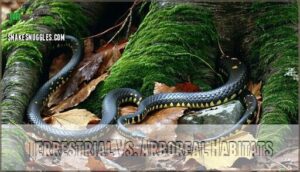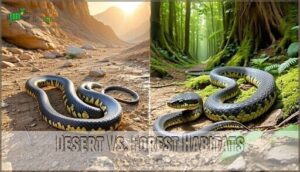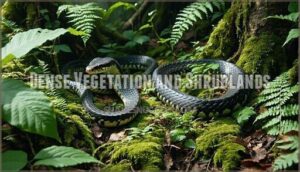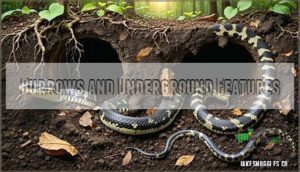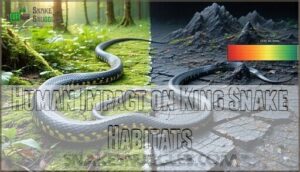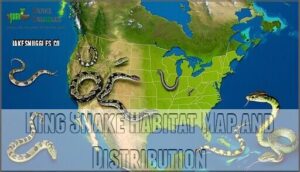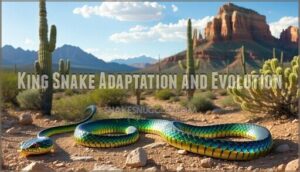This site is supported by our readers. We may earn a commission, at no cost to you, if you purchase through links.
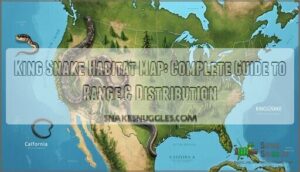
The king snake habitat map shows western kingsnakes dominating the Southwest and Pacific Coast, while eastern kingsnakes prefer southeastern forests and prairies.
California kingsnakes stick mainly to the Golden State.
These adaptable constrictors thrive everywhere from desert floors to mountain elevations of 7,000+ feet, rocky canyons to suburban backyards.
Their remarkable habitat flexibility has made them one of North America’s most successful snake species, though understanding their specific range preferences reveals fascinating patterns of adaptation and survival strategies.
Table Of Contents
- Key Takeaways
- King Snake Geographic Range
- Types of King Snake Habitats
- King Snake Habitat Features
- Climate and Temperature Preferences
- King Snake Diet and Foraging
- King Snake Predator-Prey Dynamics
- Human Impact on King Snake Habitats
- King Snake Habitat Map and Distribution
- King Snake Adaptation and Evolution
- Conservation and Management of King Snakes
- Frequently Asked Questions (FAQs)
- What time of day do king snakes come out?
- Do king snakes keep copperheads away?
- Where do king snakes live?
- What kind of snake is a king snake?
- Where do kingsnakes live in California?
- Which kingsnakes are kept in captivity?
- How long do California king snakes live?
- Is a kingsnake a colubrid species?
- Where does the king snake live?
- What is the best habitat for a king snake?
- Conclusion
Key Takeaways
- You’ll find king snakes across nearly all of North America, from southern Canada to northern Mexico, with western species dominating the Southwest and Pacific Coast while eastern varieties prefer southeastern forests and prairies.
- You can spot these adaptable constrictors thriving in remarkably diverse habitats—from desert floors at sea level to mountain elevations over 7,000 feet, including rocky canyons, dense vegetation, near-water areas, and even suburban backyards.
- You’ll discover their hunting success depends heavily on specific habitat features like rocky outcrops for shelter, dense vegetation for camouflage, and temperature ranges between 70°F-90°F that trigger seasonal activity shifts from diurnal to nocturnal patterns.
- You’re witnessing increasing threats to their habitats from human development, climate change, and habitat fragmentation, making conservation efforts focused on habitat preservation, wildlife corridors, and community education essential for their survival.
King Snake Geographic Range
You’ll find king snakes distributed across nearly all of North America, from Canada’s southern territories down to the Mexico-Guatemala border.
These adaptable reptiles occupy diverse regions including the eastern seaboard forests, western deserts, and central grasslands, with each subspecies claiming specific geographic territories, making them a diverse group.
Western Kingsnake Geographic Range
Western kingsnakes span from California to northwestern Mexico, covering diverse terrain from sea level to 7,000+ feet elevation.
This geographic range showcases remarkable adaptability across multiple climate zones and habitat types.
They’re known to be opportunistic feeders, consuming various prey.
- Range expansion occurs through natural dispersal corridors
- Habitat islands form in mountain ranges and desert oases
- Genetic diversity increases at contact zones with other subspecies
- Climate influence shapes distribution patterns across elevational gradients
Eastern Kingsnake Geographic Range
Eastern king snakes spread throughout Coastal Distribution from southern New Jersey to northern Florida, claiming Southeastern Forests as their domain.
You’ll find them across the Appalachian Range eastward, though Habitat Fragmentation limits western Alabama populations. Their Range Expansion historically covered broader territories before habitat loss.
As active hunters, they consume a variety of prey.
| Region | States | Key Features |
|---|---|---|
| Northern Limit | Southern New Jersey, Ohio | Isolated populations, cooler climates |
| Core Range | Virginia, Carolinas, Georgia | Dense populations, ideal habitats |
| Southern Edge | North Florida, Gulf Coast | Warm climates, wetland access |
| Western Boundary | Eastern Alabama | Mountain barriers, habitat transitions |
This king snake habitat map shows how eastern king snake populations adapt to diverse North America environments within their geographic range.
California Kingsnake Geographic Range
California kingsnakes thrive across diverse California landscapes, from coastal chaparral to desert valleys up to 7,000 feet elevation.
This California Kingsnake shows remarkable Habitat Variation and Range Expansion throughout the state.
Population Density peaks in riparian zones near agriculture, while GIS mapping reveals species range gaps only in high Sierras and extreme corners, supporting strong Conservation Status.
Habitat Overlap and Interactions
Where king snake territories intersect, species coexistence creates remarkable ecological drama.
Where territories collide, nature’s apex predators negotiate survival through evolutionary wisdom.
Different kingsnake species practice niche differentiation through microhabitat preferences, reducing competitive exclusion. Resource partitioning allows sympatric populations to coexist by utilizing different prey types and hunting times.
Habitat overlap zones become biodiversity hotspots where snake distribution map patterns reveal complex interactions.
- Witnessing kingsnakes share territories despite their predatory nature inspires hope for natural balance
Nature’s wisdom shines when competitors discover peaceful coexistence through intelligent resource sharing.
- Discovering how different species avoid conflict through smart resource partitioning feels reassuring
- Learning that ecological niches prevent species wars creates wonder about nature’s wisdom
- Seeing habitat overlap support greater biodiversity brings joy to conservation efforts
- Understanding sympatric speciation in action makes you feel connected to evolutionary processes
Types of King Snake Habitats
You’ll find kingsnakes thriving in remarkably diverse environments, from scorching southwestern deserts to humid eastern forests, with each species perfectly adapted to its preferred habitat type.
These adaptable serpents have mastered life in terrestrial ground-level environments, desert scrublands, forest floors, and even human-modified landscapes like farms and suburban areas, demonstrating their ability to thrive in various settings, including desert scrublands.
Terrestrial Vs. Arboreal Habitats
When mapping king snake habitat, you’ll find these adaptable serpents occupy distinct terrestrial habitats and arboreal habitats through remarkable climbing adaptations.
Most species prefer ground shelter among leaf litter and rocky crevices, while others exploit vertical niches in trees.
This habitat stratification allows different populations to access arboreal prey like bird eggs and nestlings.
Snake habitats vary dramatically – some kingsnakes rarely leave the forest floor, while others scale heights with surprising agility, showcasing nature’s flexibility.
Desert Vs. Forest Habitats
You’ll find stark contrasts between desert habitats and forest microclimates where kingsnakes thrive.
Desert species master aridity adaptations, using temperature regulation strategies while traversing rocky terrain for prey availability.
Forest habitats offer dense canopy protection and abundant leaf litter hunting grounds.
Habitat stratification creates distinct niches – from sun-baked desert floors to cool forest understories, each demanding specialized survival skills that shape kingsnake behavior, particularly in terms of temperature regulation.
Aquatic Vs. Terrestrial Habitats
Adaptation reveals the kingsnake’s terrestrial mastery versus aquatic competitors.
You’ll find these snakes prefer land-based habitat choices, though they’ll venture near water sources for Hydration Strategies.
Dietary Differences emerge where terrestrial kingsnakes hunt rodents while water snakes target fish.
Locomotion Adaptations favor ground movement over swimming.
Refuge Availability in forest habitats and desert habitats supports Reproductive Success.
Understanding where do king snakes live shows their terrestrial preference over aquatic habitats, making them true land specialists.
Human-Altered Habitats and Adaptation
You’ll find kingsnakes thriving in human-altered habitats, from urban neighborhoods to agricultural landscapes.
These adaptable serpents exploit barns, trash piles, and levees while avoiding open crop fields that increase road mortality risks.
Despite challenges from habitat destruction, fire suppression, and the pet trade, they demonstrate remarkable urban adaptation by utilizing anthropogenic resources and maintaining viable populations in fragmented environments.
King Snake Habitat Features
You’ll find kingsnakes thriving in specific habitat features that provide shelter, temperature control, and hunting opportunities across their range.
These key microhabitats—from rocky crevices to underground burrows—determine where different kingsnake species establish their territories and survive seasonal changes, and are crucial for their survival in terms of temperature control.
Rocky Outcrops and Canyons
Rocky outcrops and canyons offer king snakes prime real estate with unbeatable amenities.
These rugged landscapes provide natural fortresses where reptiles find safety and comfort year-round.
- Canyon Microclimates create perfect temperature zones for thermal regulation
- Shelter Features include deep crevices and ledges for protection
- Rocky Outcrops serve as basking platforms for warming up
- Prey Availability attracts rodents and lizards to hunt
Speckled Kingsnake populations thrive here, utilizing these natural strongholds effectively.
Consider using a reptile canyon background to enhance a king snake’s enclosure.
Dense Vegetation and Shrublands
You’ll find king snakes thriving in dense vegetation and shrublands, where they’ve mastered camouflage strategies and ambush hunting techniques.
These clever serpents use thick brush for shelter provision, taking advantage of natural cover to avoid predators and surprise prey.
Human impact affects their king snake range, but habitat restoration efforts help maintain these critical areas.
Essential habitat components are often commercially available to support conservation efforts, and can be found at Essential habitat components.
Geographic information system technology supports habitat mapping projects, while reptile habitat maps guide conservation work in dense vegetation zones where these adaptable snakes continue flourishing.
| Habitat Feature | Hunting Advantage | Conservation Need |
|---|---|---|
| Dense shrubs | Perfect camouflage | Preserve corridors |
| Thick understory | Ambush opportunities | Reduce fragmentation |
| Natural burrows | Safe shelter | Restore connectivity |
Near-Water Habitats and Aquatic Features
Water sources attract king snakes seeking aquatic prey like frogs and fish.
You’ll spot them basking near streams, ponds, and riparian zones where hydration needs meet hunting opportunities.
Their flood tolerance and ability to navigate various water quality conditions make nearwater habitats prime locations.
- Aquatic prey abundance provides reliable food sources year-round
- Basking spots on logs and rocks offer thermoregulation opportunities
- Riparian zones create diverse microhabitats with varied shelter options
- Water access supports hydration needs during hot, dry periods
Burrows and Underground Features
Underground retreats serve as kingsnakes’ ultimate survival strategy. These hibernation sites provide essential predator protection and regulate burrow temperature for ideal comfort.
- Substrate preferences include loose soil, leaf litter, and decaying logs
- Underground ecosystems support diverse prey and shelter opportunities
- Habitat suitability depends on drainage, depth, and spatial distribution
You’ll find their ecological niche perfectly adapted to subterranean living. Kingsnake enthusiasts often seek specialized burrow products to enhance their habitats.
Climate and Temperature Preferences
You’ll discover that kingsnakes thrive in temperatures between 70°F and 90°F, adjusting their activity patterns as seasons change.
Understanding these climate preferences helps you predict where you’re most likely to encounter different kingsnake species across their vast North American range, which is a key factor in kingsnake species distribution.
Temperature Ranges and Activity Patterns
King snakes demonstrate remarkable thermal tolerance, staying active in temperature ranges from 70°F to 90°F.
You’ll observe their diurnal activity shifting to nocturnal patterns during summer heat.
Microclimate influence shapes their spatial distribution, while seasonal brumation occurs during winter months, lasting 50-87 days across their ecological niche.
| Activity Pattern | Temperature Range |
|---|---|
| Peak Activity | 70°F – 90°F |
| Nocturnal Shifts | Above 90°F |
| Brumation | Below 50°F |
| Ideal Range | 75°F – 85°F |
Humidity and Precipitation Preferences
While king snakes can handle scorching deserts or steamy swamps, their climate preferences vary dramatically by species and location.
Arid Zone Kingsnakes thrive with minimal precipitation, while Humid Forest Kingsnakes need consistent moisture for hunting success.
- Desert dwellers endure months without significant rainfall, relying on prey for hydration
- Forest species require steady precipitation to maintain dense vegetation cover
- Microclimate humidity influences daily activity patterns and shelter selection
- Seasonal rainfall directly impacts prey availability and reproductive timing
Seasonal Changes and Hibernation
When temperatures drop below 50°F, you’ll find king snakes preparing for brumation—their version of hibernation. Brumation Duration typically spans 50-87 days, depending on local climate preferences.
These reptiles seek hibernation sites in hollow logs, burrows, or rock crevices for temperature regulation. Activity Patterns shift dramatically as daylight shrinks.
Your snake’s seasonal diet changes too, requiring fewer meals before entering dormancy.
Seasonal changes trigger these natural rhythms perfectly.
Adaptation to Climate Change
As temperatures rise, king snakes showcase remarkable adaptation to climate change through strategic survival mechanisms.
- Range shifts – Moving northward to escape excessive heat while colonizing cooler territories
- Brumation changes – Adjusting dormancy periods based on shifting seasonal patterns
- Heat tolerance – Enhanced physiological resilience to temperature extremes
- Conservation strategies – Exploiting diverse microhabitats and prey impacts for survival
King Snake Diet and Foraging
You’ll discover that king snakes are opportunistic predators with remarkably diverse diets that change based on their habitat and seasonal prey availability.
Their hunting success depends heavily on the specific environment they inhabit, from desert rodent populations to forest amphibian communities.
Prey Preferences and Hunting Strategies
You’ll discover these snakes are opportunistic predators with impressive venom resistance that lets them tackle venomous species other predators avoid.
Their king snake diet includes rodents, birds, lizards, and even rattlesnakes.
Using powerful constriction techniques, they squeeze prey until circulation stops.
Prey detection relies on chemical cues through tongue-flicking, while seasonal foraging patterns shift with temperature changes affecting prey availability.
Foraging Behavior and Activity Patterns
You’ll notice king snakes are opportunistic hunters with flexible activity cycles.
Their foraging behavior shifts between diurnal and nocturnal activity based on temperature and prey preferences.
Seasonal foraging patterns change throughout the year, with hunting strategies adapting to available prey.
These adaptable prey detection methods and behavioral flexibility make their king snake diet remarkably diverse across different habitats.
Competition With Other Predators
When you understand king snake foraging patterns, you’ll notice interspecific competition creates fascinating niche overlap scenarios.
Hawks, raccoons, and foxes compete for similar prey, forcing resource partitioning strategies.
Predator abundance directly affects competitive exclusion dynamics in shared habitat zones.
King snake predators like larger raptors intensify these competition with predators scenarios, shaping predator-prey dynamics across their range.
Impact of Habitat on Diet and Foraging
Habitat distribution directly influences what you’ll find on a king snake’s menu, creating fascinating diet specialization patterns across their range.
Forest kingsnakes feast on abundant rodents and birds, while desert dwellers adapt to lizards and smaller prey.
Urban foraging risks change their hunting game completely—city snakes often encounter different prey species than their wild cousins.
Seasonal food shifts reflect habitat prey abundance, with foraging microclimates offering unique opportunities.
- Dense woodlands – Rich rodent populations create snake buffets
- Rocky desert canyons – Lizards basking on sun-warmed stones
- Wetland edges – Frogs calling from shallow pools
- Urban park corners – Mice scurrying near trash bins
King Snake Predator-Prey Dynamics
You’ll find that king snakes exist within complex predator-prey relationships that vary dramatically based on their specific habitat and geographic location.
These dynamics directly influence everything from their hunting success to their own survival strategies, creating fascinating ecological webs that shift between desert canyons, forest floors, and grassland edges, forming intricate ecological systems.
Predators of King Snakes
King snakes face threats from hawks, eagles, coyotes, and raccoons.
Juvenile vulnerability peaks during their first year when predator identification becomes vital for survival.
Their defense mechanisms include releasing foul odors and mimicking coral snakes.
Habitat influence affects predator encounters—dense vegetation provides cover while open areas increase exposure, impacting population dynamics through varying predation pressure.
Prey Species and Population Dynamics
Your snake’s menu changes dramatically based on prey abundance and habitat conditions.
Kingsnakes demonstrate remarkable diet variation, switching between rodents, lizards, birds, and other snakes as population cycles fluctuate throughout seasons.
Here’s how prey availability shapes king snake diet:
- Rodent Control – Primary focus during mouse and rat population booms
- Predator Impact – Reduces venomous snake numbers through ophiophagy
- Invasive Prey – Adapts to non-native species like house geckos
- Snake Prey – Targets competing serpents when mammal numbers decline
- Predatorprey Dynamics – Adjusts hunting patterns based on seasonal prey movements
Impact of Habitat on Predator-Prey Interactions
Environmental conditions dramatically shape how king snakes interact with both prey and predators.
Habitat complexity creates ambush opportunities while affecting hunting success rates. Dense vegetation increases prey availability but also predator abundance, creating a delicate balance.
Microclimate effects influence when snakes hunt versus hide. Open grasslands favor different predatorprey dynamics than rocky outcrops, with each king snake environment requiring specific habitat selection strategies that ecological modeling helps scientists understand and predict.
Adaptation to Predator-Prey Dynamics
These adaptations showcase nature’s evolutionary arms race in action.
King snakes have developed remarkable survival strategies that keep them thriving across diverse habitats:
- Venom resistance allows them to hunt venomous snakes like rattlesnakes without fear
- Camouflage strategies help them blend seamlessly into their king snake environment
- Hunting efficiency maximizes prey availability through opportunistic feeding patterns
Their habitat selection directly influences predator avoidance and snake diet success.
Human Impact on King Snake Habitats
You’re witnessing unprecedented changes to king snake habitats as human activities reshape the landscapes these serpents have called home for millennia.
From urban sprawl fragmenting ancient migration routes to climate change shifting temperature zones, your understanding of these impacts becomes essential for protecting one of North America’s most beneficial predators, with a focus on protecting.
Habitat Destruction and Fragmentation
How does habitat destruction impact kingsnakes?
Habitat loss fragments their territories into isolated patches, preventing movement between populations.
Road mortality, wetland filling, and urbanization effects create deadly barriers.
Fire suppression reduces natural habitat quality, while human-altered habitats offer poor substitutes.
You’ll find habitat fragmentation forces snakes into unsuitable areas, threatening their survival and genetic diversity.
Climate Change and Habitat Alteration
Climate change forces king snakes into range shifting as temperatures rise beyond their comfort zones.
You’ll notice these adaptable serpents moving to cooler territories when their current habitats become too hot. Water scarcity and altered fire frequency disrupt their ecosystems, while habitat loss accelerates.
They may even exploit artificial suburban structures for shelter.
Effective conservation strategies require:
- Climate adaptation planning using habitat distribution models
- Species distribution model updates tracking population movements
- Ecological niche modeling to predict future suitable areas
- Spatial analysis identifying climate refugia for protection
Invasive Species and Competition
California kingsnake populations have exploded in non-native territories, devastating local ecosystems.
These serpentine invaders outcompete native predators through superior hunting abilities and immunity to venomous prey.
Their expansion threatens endemic species survival through resource competition, habitat alteration, and disease transmission from exotic pet trade releases.
| Impact Category | Affected Species | Population Decline |
|---|---|---|
| Giant Lizards | Gallotia stehlini | >99% reduction |
| Endemic Skinks | Chalcides sexlineatus | >80% reduction |
| Native Geckos | Tarentola boettgeri | >50% reduction |
| Ecosystem Balance | Multiple species | Cascading effects |
| Biodiversity Loss | Island endemics | Irreversible damage |
These biological bulldozers create ecological dominoes through fire ant predation impacts and habitat distribution model disruptions.
Species range mapping reveals their unstoppable march across vulnerable island ecosystems, while ecological niche modeling shows overlapping territories with native fauna, intensifying competition for limited resources.
Conservation Efforts and Habitat Restoration
You’ll find that habitat restoration efforts are making real progress through targeted conservation efforts.
Population monitoring helps track recovery success, while threat mitigation programs address specific challenges like road mortality and fire ant predation.
Public awareness campaigns educate communities about kingsnakes’ pest control benefits.
Map-based conservation planning guides habitat preservation priorities, creating wildlife corridors that boost ecosystem resilience and support sustainable species range mapping for long-term protection.
King Snake Habitat Map and Distribution
You’ll discover that king snake habitat maps reveal fascinating distribution patterns across North America, from desert valleys in California to humid forests in Florida.
These visual tools help scientists track population changes and guide conservation efforts by showing where different species overlap and adapt to changing environments.
Geographic Range and Distribution Patterns
Kingsnakes showcase remarkable range overlap across North America’s diverse landscapes. Distribution factors like terrain and prey availability shape where you’ll spot these adaptable reptiles.
Climate influence drives their geographic data patterns, while habitat fragmentation creates patchy populations. Understanding snake distribution helps with conservation mapping efforts.
Key distribution patterns include:
- Coast-to-coast presence from Canada to Guatemala
- North American snakes thriving in 48 US states
- Dense populations in California, Texas, and southeastern regions
- Spatial data showing preference for edge habitats
- Snake species map revealing subspecies clustering by region
Human development hasn’t stopped these resilient hunters from claiming territory everywhere.
Habitat Suitability and Modeling
Through habitat suitability modeling, you’ll discover how scientists use predictive modeling and habitat variables to create accurate species distribution maps for kingsnakes.
These spatial habitat modeling techniques analyze climate impacts and environmental factors, generating suitability scores that guide conservation planning.
Modern habitat mapping techniques and species range modeling help predict where kingsnakes thrive, making species distribution mapping essential for protecting their future habitats.
Map-Based Conservation Planning
GIS technology transforms species distribution mapping into powerful conservation planning tools. You’re basically creating a strategic blueprint that guides where protection efforts will have maximum impact.
Mapbased conservation planning uses predictive modeling to identify priority areas:
- Corridor prioritization connects fragmented king snake populations across landscapes
- Habitat connectivity analysis reveals critical movement pathways between suitable territories
- Conservation effectiveness modeling predicts which protected areas will best support long-term population stability
These spatial distribution models help conservation groups make data-driven decisions about land acquisition and management. Adaptive strategies emerge from understanding how king snakes use different habitat patches, ensuring your conservation dollars work smarter, not harder.
Citizen Science and Community Engagement
You can become part of the solution by contributing citizen science observations through smartphone apps and community programs.
Data collection from your backyard sightings helps researchers track species distribution patterns across North America.
Community involvement in habitat assessment projects strengthens conservation awareness while building valuable ecological data databases.
The use of GPS snake tracking provides detailed movement data.
Educational outreach programs teach identification skills, transforming curious neighbors into effective community engagement partners for kingsnake protection efforts.
King Snake Adaptation and Evolution
You’ll discover how king snakes evolved remarkable adaptations that let them thrive across North America’s diverse landscapes, from scorching deserts to humid forests.
Their evolutionary journey reveals fascinating genetic variations and survival strategies that continue shaping conservation efforts today.
Evolutionary History and Phylogenetics
Deep within kingsnake evolutionary history lies a fascinating story spanning millions of years.
Their phylogenetic relationships reveal ancestral traits that shaped modern species divergence across North America.
Genetic ancestry studies show how evolutionary adaptations helped Lampropeltis getula and relatives colonize diverse habitats.
- Ancient lineages split during climate shifts, creating today’s distinct species
- Genetic variation increased as populations adapted to new environments
- Species divergence accelerated through geographic isolation and habitat specialization
Adaptation to Different Habitats
You’ll find king snakes demonstrate remarkable Behavioral Plasticity and Climatic Tolerance across environments.
Their Habitat Specificity varies dramatically—desert populations develop heat resistance while forest dwellers excel in humid conditions.
Morphological Variation includes size differences and scale patterns suited to local conditions.
Dietary Adaptations shift based on prey availability, showcasing incredible adaptation to habitats through evolutionary fine-tuning.
Maintaining proper humidity is vital, so consider reptile humidifier options to guarantee a healthy environment.
Genetic Variation and Population Structure
When you examine king snake populations, you’ll discover striking genetic diversity shaped by population isolation and environmental barriers.
Three main lineages exist: California, desert, and eastern groups, with hybridization zones creating genetic mixing.
Phylogeography patterns reveal how climate cycles drove isolation and reconnection.
Conservation genetics shows asymmetric gene flow—more migration flows west-to-east than reverse.
This phylogenetics data guides species range analysis and habitat distribution modeling for protection strategies.
Conservation Implications of Adaptation
Understanding adaptive capacity proves essential for species conservation success.
Genetic diversity enables kingsnakes to survive habitat loss and develop climate resilience.
Effective conservation strategies must protect diverse populations across their habitat distribution range, ensuring these adaptable serpents maintain their evolutionary flexibility.
Smart habitat conservation planning considers conservation implications of local adaptations, supporting long-term population stability.
Conservation and Management of King Snakes
You’ll find that protecting king snake populations requires a balanced approach combining habitat preservation with active monitoring programs.
Conservation efforts must address threats like habitat fragmentation, road mortality, and overcollection while educating communities about these beneficial predators’ ecological importance.
Habitat Conservation and Restoration
Protecting king snake populations requires strategic habitat conservation efforts that address mounting environmental pressures.
You’ll find success through targeted approaches that restore degraded landscapes while creating sustainable corridors.
- Habitat Preservation: Establish protected areas focusing on critical breeding grounds and overwintering sites through thorough ecological assessment.
- Fire Management: Implement controlled burns in fire-adapted ecosystems, particularly longleaf pine habitats where scarlet kingsnakes thrive.
- Wetland Restoration: Reconstruct aquatic boundaries and marshlands that support diverse prey populations essential for species conservation.
Population Management and Monitoring
Effective population management requires systematic monitoring through mark-recapture studies and genetic diversity assessments.
You’ll find PIT tagging and scale clipping reveal key population trends while species modeling helps predict habitat connectivity needs.
Threat mitigation strategies depend on spatial ecology data from citizen science programs.
These conservation strategies combine habitat analysis with species distribution techniques, creating thorough management plans that address declining populations through evidence-based approaches.
Eastern kingsnakes’ immunity to venom also makes them essential for controlling venomous snake populations.
Education and Outreach Programs
Public awareness campaigns help communities understand king snake conservation through hands-on learning experiences.
These education programs transform how you view snake habitats by connecting science with everyday life.
- School programs bring live demonstrations and interactive presentations directly to classrooms
- Citizen science projects let you contribute valuable data while exploring local ecosystems
- Community engagement events at nature centers offer family-friendly snake awareness activities
- Conservation education workshops teach habitat protection techniques you can implement at home
Research and Conservation Priorities
Research priorities zero in on king snake survival through targeted action.
Scientists focus on habitat restoration, genetic diversity studies, and population monitoring to combat declining numbers effectively.
| Research Priority | Conservation Action |
|---|---|
| Habitat Preservation | Protect critical breeding grounds and migration corridors |
| Genetic Diversity | Study population genetics to maintain healthy gene pools |
| Fire Management | Balance prescribed burns with snake habitat needs |
| Invasive Control | Remove non-native species competing for resources |
| Population Monitoring | Track numbers using radio telemetry and citizen science |
Ecological research drives snake conservation by identifying threats before they become critical.
Conservation biology helps researchers understand how habitat fragmentation affects king snake populations across their range, which is crucial for effective conservation and population monitoring.
Frequently Asked Questions (FAQs)
What time of day do king snakes come out?
King snakes are primarily active during the day (diurnal), but they’ll shift to dawn, dusk, or nighttime hours when temperatures soar above 90°F in summer months.
Do king snakes keep copperheads away?
Yes, kingsnakes do help control copperhead populations by actively hunting and eating venomous snakes, including copperheads. Their presence can deter copperheads from settling in an area.
Where do king snakes live?
You’ll find king snakes throughout North America, from Canada to Guatemala.
They adapt to diverse habitats including forests, deserts, grasslands, rocky outcrops, and even urban areas, making them remarkably versatile survivors.
What kind of snake is a king snake?
King snakes are non-venomous constrictors that belong to the genus Lampropeltis.
You’ll recognize them by their smooth scales and distinctive banding patterns, often mimicking venomous coral snakes for protection against predators, utilizing a method that can be described as mimicking.
Where do kingsnakes live in California?
Like scattered gems across California’s diverse landscape, you’ll discover kingsnakes thriving in deserts, woodlands, grasslands, chaparral, agricultural areas, and riparian zones throughout the state’s varied terrain.
Which kingsnakes are kept in captivity?
California kingsnakes, eastern kingsnakes, scarlet kingsnakes, and speckled kingsnakes are commonly kept as pets.
You’ll find captive breeding has reduced wild collection pressure, though overcollection historically impacted populations before commercial breeding programs developed.
How long do California king snakes live?
Wild California king snakes typically live 12-18 years, while you’ll find captive specimens often reach 20-25 years with proper care, nutrition, and veterinary attention in controlled environments.
Is a kingsnake a colubrid species?
When you’re identifying that sleek snake in your backyard, you’ll discover kingsnakes belong to Colubridae, the world’s largest snake family.
Yes, kingsnakes are colubrids, sharing this classification with over 1,800 other non-venomous species worldwide.
Where does the king snake live?
You’ll find king snakes throughout North America, from Canada’s southern regions down to Central America. They’ve adapted to diverse habitats including forests, deserts, grasslands, and even urban areas.
What is the best habitat for a king snake?
You’ll want diverse habitats with hiding spots like rocky outcrops, dense vegetation, or fallen logs.
Temperatures between 70-90°F work best, whether in forests, grasslands, or even desert areas with adequate shelter, providing diverse habitats.
Conclusion
Understanding this king snake habitat map reveals nature’s master class in adaptability.
You’ve discovered how these remarkable constrictors have conquered diverse landscapes from Canadian forests to Mexican deserts, each species carving out its perfect niche.
Whether you’re tracking western kingsnakes through rocky canyons or spotting eastern varieties in humid woodlands, you’ll appreciate their incredible habitat flexibility.
This detailed king snake habitat map shows why they’ve become North America’s most successful serpents, thriving everywhere from pristine wilderness to your own backyard, demonstrating their ability to thrive in various environments with diverse landscapes.
- https://cnah.org/taxon.aspx?taxon=Lampropeltis_californiae
- https://www.desertmuseum.org/books/nhsd_kingsnake.php
- https://pmc.ncbi.nlm.nih.gov/articles/PMC9937589/
- https://animaldiversity.org/accounts/Lampropeltis_getula/
- https://www.chattnaturecenter.org/visit/experience/wildlife/animal-facts/eastern-king-snake/

